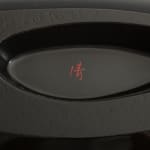Kubo Kinpei
Flower Vessel titled “Black Elephant”, 1960s
Kanshitsu dry-lacquer with roiro mirror-black finish
Size 7 x 18 x 7½ in. (17.7 x 46 x 19.5 cm)
T-4816
Further images
-
(View a larger image of thumbnail 1
)

-
(View a larger image of thumbnail 2
)

-
(View a larger image of thumbnail 3
)

-
(View a larger image of thumbnail 4
)

-
(View a larger image of thumbnail 5
)

-
(View a larger image of thumbnail 6
)

-
(View a larger image of thumbnail 7
)

-
(View a larger image of thumbnail 8
)

A kaki (flower container) of organic sculptural form worked in the kanshitsu (dried-lacquer) technique and with a highly polished black-lacquer surface, the underside with a broad foot ring finished with...
A kaki (flower container) of organic sculptural form worked in the kanshitsu (dried-lacquer) technique and with a highly polished black-lacquer surface, the underside with a broad foot ring finished with a roughly textured surface surrounding a recessed polished lacquer base signed with a red-lacquer character Kiyoshi
Comes with a wood tomobako storage box inscribed Kanshitsu kaki kokuzo (Dried-lacquer flower vessel, “Black Elephant”); signed Kiyoshi and sealed Naka
The unidentified artist here adopts the ancient kanshitsu (“dried lacquer” or “dry lacquer”) method, originally used more than a millennium ago to create Buddhist statuary, combining layers of hemp cloth with the dark, sticky sap of the lacquer tree (Rhus verniciflua). Once the body has been formed and left to set in the furo curing cabinet, assuring a constant temperature and relative humidity, a host of elaborate processes were required to transform it into a gleaming vessel for displaying an ikebana flower arrangement: filling, smoothing, applying, and layer upon layer of filtered lacquer colored black through the addition of iron filings, with further time in the furo after each layer was complete, and finally smoothing and polishing the surface several times more, using stone, charcoal, and powdered stag horn.
We have been unable to identify the maker of this piece but a dried-lacquer flower vessel with the same unusual descriptive title was made by the lacquer artist Kubo Kinpei (1902-1968), apparently toward the end of his career. Kubo studied under the first Suzuki Hyosaku (1874-1943), one of the founding fathers of modern Kyoto lacquer art who also made works using the kanshitsu technique. The present flower container, likely made by a leading pupil of Kubo Kinpei, is an outstanding example of that special Kyoto genius for adopting traditional techniques and putting them in the service of an elegant, unmistakably Japanese modernist project.
Comes with a wood tomobako storage box inscribed Kanshitsu kaki kokuzo (Dried-lacquer flower vessel, “Black Elephant”); signed Kiyoshi and sealed Naka
The unidentified artist here adopts the ancient kanshitsu (“dried lacquer” or “dry lacquer”) method, originally used more than a millennium ago to create Buddhist statuary, combining layers of hemp cloth with the dark, sticky sap of the lacquer tree (Rhus verniciflua). Once the body has been formed and left to set in the furo curing cabinet, assuring a constant temperature and relative humidity, a host of elaborate processes were required to transform it into a gleaming vessel for displaying an ikebana flower arrangement: filling, smoothing, applying, and layer upon layer of filtered lacquer colored black through the addition of iron filings, with further time in the furo after each layer was complete, and finally smoothing and polishing the surface several times more, using stone, charcoal, and powdered stag horn.
We have been unable to identify the maker of this piece but a dried-lacquer flower vessel with the same unusual descriptive title was made by the lacquer artist Kubo Kinpei (1902-1968), apparently toward the end of his career. Kubo studied under the first Suzuki Hyosaku (1874-1943), one of the founding fathers of modern Kyoto lacquer art who also made works using the kanshitsu technique. The present flower container, likely made by a leading pupil of Kubo Kinpei, is an outstanding example of that special Kyoto genius for adopting traditional techniques and putting them in the service of an elegant, unmistakably Japanese modernist project.







